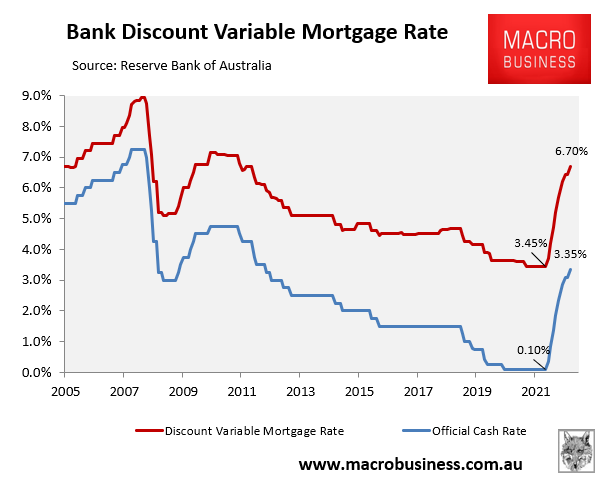A Finder survey has revealed that one in eight mortgage holders have missed a payment owing to the Reserve Bank of Australia’s (RBA) aggressive monetary tightening, which has lifted the official cash rate a record 3.25% in only 10 months:

Specifically, Finder found that 13% of mortgage holders have missed a repayment in the past 6 months, equivalent to 429,000 households. Of those, 7% had missed just one payment, while 6% had missed multiple repayments.
“Nine consecutive rate hikes from the RBA means an Australian with the average loan size of around $600k will be paying roughly $1,000 more per month compared to what they were paying in April last year”, Finder’s home loans expert Richard Whitten said.
“Households are really struggling with the monthly outlay and some just can’t keep up”.
“With further rate hikes predicted – things could be about to get worse”, Whitten warned.
The mortgage situation is only going to get worse.
Last week, Barrenjoey’s analysts estimated that the average Australian borrower’s mortgage repayments are still around 180 basis points behind the RBA’s current rate-raising profile. This means that the RBA’s rate hikes have yet to hit their cash flows and the wider economy.
The RBA has also flagged further rate hikes in the months ahead.
Meanwhile, KPMG estimates that more than 800,000 fixed-interest mortgages that were taken out in recent years will transition to variable rate loans in 2023.
KPMG Australia’s chief economist Brendan Rynne estimates that people with the average mortgage loan of $600,000 will face a $16,500 increase in their annual interest payments when they are switched from a fixed-rate loan to variable rates.
Rynne adds that household expenditure could potentially fall by around $20 billion if the cash rate is increased another three times in 2023. In turn, this would reduce annual GDP growth by around 1%.
Household consumption is the economy’s biggest driver, accounting for 55% of output in a typical quarter.
Therefore, the sharp contraction in household consumption risks pulling the economy into recession, alongside causing a wave of forced home sales.
If you are looking to save thousands of dollars in mortgage repayments, try the Compare n Save mortgage comparison tool. It takes less than a minute. And if you wish to refinance, the process is easy.

